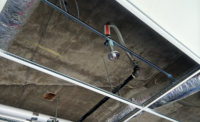Recent research at Canada's Institute for Research in Construction (IRC) will have implications for the use of water-mist systems as a replacement for halon in certain circumstances.
Following the ban on halon production by the Montreal Protocol, IRC's Fire Risk Management Program, in partnership with the Department of National Defence (DND), has been looking for alternative fire-suppression systems to use as replacements for existing equipment and in future designs. It is of primary importance that the use of such systems does not compromise the firefighting effectiveness currently provided by halon, have negative implications for the environment nor create unacceptable safety risks.
Water-mist fire-suppression systems have good potential to satisfy all of the above criteria. Recently, IRC carried out full-scale tests to study the feasibility of using water mist as an alternative to halon in DND Halifax Class Frigates, and to compare the fire-extinguishing performance of water-mist systems to that of gaseous agents evaluated previously. As part of the tests, a mock-up of a diesel engine casing was installed in the test compartment. The researchers chose fire scenarios-including different sizes, types and locations of fires-that presented the greatest challenge for water mist to extinguish. Ventilation conditions varied from closed door to open door (natural ventilation system) to open door combined with an operating exhaust fan (forced ventilation system). Two types of water-mist systems were used in the tests: 1) a single-fluid/high-pressure system and 2) a twin-fluid/low-pressure system. In addition, the effects of two water-mist discharge modes, continuous and cycling discharges, were examined.
The test results showed that the time required for extinguishing fires when water-mist systems were used was longer than when gaseous agents were used. However, water mist quickly controlled fires and significantly cooled the test compartment, hence keeping combustion products (CO and CO2) in the compartment at a low level. The thermal conditions and gas concentrations in the compartment, after the water-mist application, were safe enough for firefighters to enter the compartment immediately.
Safe levels of CO, CO2
The measurements from the tests showed that water mist did not produce thermal decomposition products as a result of the breakdown of halocarbon agents during fire suppression. In all tests, the CO and CO2 concentrations in the test compartment were not high enough to pose an immediate danger to life and health.The results also showed that water-mist systems were able to extinguish a wide variety of fires under ventilated conditions, while the gaseous agents were not effective in extinguishing fires under these conditions. Ventilation in the compartment reduced the CO and CO2 concentrations in the room, but prolonged the time required to extinguish the fire because of the additional oxygen supply.
One of the significant findings from the tests was that the performance of the water-mist system, in terms of extinguishing the fire, could be substantially improved by using the cycling discharge mode rather than the continuous discharge mode. When the type of fire was one where water mist could easily extinguish it, the improvement achieved by using the cycling discharge was not significant. However, even for these conditions, it was possible to reduce the amount of water required to extinguish the fire by using the cycling discharge.
For fires that are more difficult to extinguish with water mist-for example, small fires, shielded fires and fires in ventilated conditions-both the time required to extinguish the fire and the amount of water required were substantially reduced when the cycling discharge was used. The test results showed that the water requirement was one-third, and the time to extinguish the fire was one-half that of the continuous discharge. The cycling water-mist discharge also extinguished fires that the continuous discharge could not.
The test results also showed that unlike other fire-suppression agents, the water-mist discharge created strong dynamics that mixed combustion products with steam in the compartment, which played an important role in putting out the fire and reducing the impact of air convection on extinguishing fires.
The full-scale tests and corresponding analysis carried out by IRC provided new insights into water-mist systems as an alternative to Halon 1301. In addition, some possible approaches for further improvement of water-mist fire-suppression performance were identified.
Reprinted with permission by Construction Innovation, a quarterly publication of the Canadian National Research Council's (NRC) Institute for Research in Construction.
